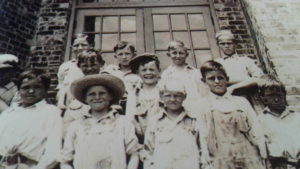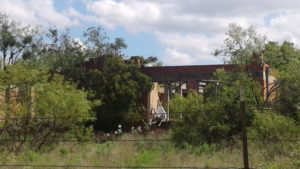Necessity is located in southeastern Stephens County, Texas. It was first called Mountain Valley and later Cotton Plant. It got the present name when the community applied for a post office. The application stated that it was a necessity that the town have a post office. The approval came back for a post office at Necessity, Texas.
My family was in Necessity before 1920. They, along with other relatives, lived and farmed in Necessity and the surrounding area. My parents started their dairy there before later moving to Breckenridge.
The school was the center for activities both academic and social. Church was held at the school on Sundays with itinerant preachers from different denominations rotating. My sister and brother started school there, my sister in 1921 and my brother in 1927. At one time the school reportedly had ten teachers. When there was a program at the school, most people attended even if they had no children in school. A family story involves my sister at age five. The parents of one of her playmates were both teachers. My parents were very proud of their little girl. They attended a program at the school and had her dressed up in new clothes. She even had new shoes. The parents of her little friend asked if she could sit with their daughter. My parents agreed. During the program, my parents were astounded when the teacher called my sister to the stage. They were even more surprised when she did a recitation that went like this:
“There once was a young man named Ash,
Who gave to his wife all of his cash.
She spent it all for dresses
And now she confesses
They have nothing to eat but hash.”
This brought thundering applause. They were still telling this story many years later.



Note that earlier pictures are of a frame building. The last one is brick. I am guessing that my brother is 8 or 9 years old, which would make this about 1929 or 1930.
When oil was discovered in Stephens County, the population of Necessity swelled to 20,000. Many farmers left farming to work in the oil field. There were two banks and numerous stores. The remains of one of the bank vaults can be seen today alongside a county road. My maternal grandmother, Evangeline Haskins, operated a boarding house during the boom. Eventually the boom moved northward and young people left for careers other than farming. Today the population is less than 30. There is still a church and the ruins of the school building are near it.
My parents moved to Breckenridge before I was born, but their ties to Necessity remained strong. For many years, Sunday afternoons were spent in Necessity visiting friends and relatives. I vaguely remember that there was still a general store at that time. While the adults sat on the front porch visiting, I entertained myself with toys.
A big Necessity event was the graveyard working, or as more genteel folks called it, the cemetery working. The Necessity Cemetery is the largest rural cemetery in Stephens County. My parents, maternal and paternal grandparents, brother, and many aunts, uncles, and cousins are buried there. The work days are held the first Saturday in May and September. In earlier days, if people moved away and could only come home occasionally, they came the first Saturday in May for the cemetery working. It was like a homecoming. The parking area and the roadway overflowed with cars. My parents always attended when I was a child. People brought their hoes and rakes and cleaned the cemetery. Work was followed by “dinner on the ground.” Wide boards were placed on sawhorses and loaded with the food each family had brought. In those days a barrel was placed atop an open fire to make coffee. When I saw the fire going under the coffee, I knew this meant that food would soon be coming out of the baskets and boxes. This was a great time for children. It meant all of the fried chicken and chocolate cake we could eat.
When I married, I told my husband I wanted to visit my family on the weekend of the graveyard working. He asked, “For the what?” He soon fell into the custom. When we had children, they became accustomed to going to Necessity. Our youngest son had trouble with the terminology when he was about three or four years old. He raised more than a few eyebrows when he told people he was going “to the grave digging.” On another occasion the children were puzzled by another old expression. We arrived on the given Saturday and were soon surrounded by relatives greeting us. There was a new grave near where we parked. Ken asked my brother if it was anyone we knew. My brother answered that it was a new arrival to the area and he “went over to Fort Worth and got knocked in the head.” The children’s eyes widened. I knew they did not know what happened to the poor fellow. I explained to them that was an old fashioned expression meaning he got hit over the head and killed.
The crowds are dwindling, but my family still attends if possible. There is now an association which hires a caretaker to mow and clean several times a year. The old arbor has been replaced with a nice covered pavilion. Lunch is still served. Visitors renew friendships, reminisce, and get caught up on local news.



Pictured in 2016


Comments
2 responses to “A TOWN CALLED NECESSITY”
Jewel Langford wrote the inscription for the cemetery. There is a copy in her cedar chest in her handwriting . She was in charge of many things such as the mowing etc. She is greatly missed. Lou Ann Langford
I did not know that. I will add that to notes I leave for the family. I have a picture of her (somewhere?) in her 80’s up on a ladder helping at the church, painting I believe. She was a treasure.